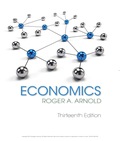
Median voter model and its exceptions.
Explanation of Solution
The median voter model refers to a two-person contest where the endeavor of political candidates matches the median voter’s preferences. The two politicians, Barry Goldwater (1964) and George McGovern (1972), are at the right and left end of the two ranges from middle, respectively. These two candidates may fall into the middle of the two ranges. However, it is difficult to find out the middle. Thus, it is necessary to note the activities of respective political parties in the next years.
During the presidential election of 1964, the Republican Party with Goldwater suffered a defeat and party chooses a candidate Richard Nixon, who is nearer to the middle of the two ranges. During the election of 1968, the Republican Party wins.
During the election of 1972, the Democratic Party suffered a defeat with George McGovern and party chooses a candidate, Jimmy Carter, who is nearer to the middle of the two ranges and wins in the election of 1976.
Thus, these are not necessarily exceptions to the theory of median voter but correct statements.
Median voter model: Median voter model refers to a two-person contest where the endeavor of political candidates matches the median voter’s preferences.
Want to see more full solutions like this?
Chapter 31 Solutions
Economics (MindTap Course List)
- how commond economies relate to principle Of Economics ?arrow_forwardCritically analyse the five (5) characteristics of Ubuntu and provide examples of how they apply to the National Health Insurance (NHI) in South Africa.arrow_forwardCritically analyse the five (5) characteristics of Ubuntu and provide examples of how they apply to the National Health Insurance (NHI) in South Africa.arrow_forward
- Outline the nine (9) consumer rights as specified in the Consumer Rights Act in South Africa.arrow_forwardIn what ways could you show the attractiveness of Philippines in the form of videos/campaigns to foreign investors? Cite 10 examples.arrow_forwardExplain the following terms and provide an example for each term: • Corruption • Fraud • Briberyarrow_forward
 Economics (MindTap Course List)EconomicsISBN:9781337617383Author:Roger A. ArnoldPublisher:Cengage Learning
Economics (MindTap Course List)EconomicsISBN:9781337617383Author:Roger A. ArnoldPublisher:Cengage Learning

 Exploring EconomicsEconomicsISBN:9781544336329Author:Robert L. SextonPublisher:SAGE Publications, Inc
Exploring EconomicsEconomicsISBN:9781544336329Author:Robert L. SextonPublisher:SAGE Publications, Inc Microeconomics: Private and Public Choice (MindTa...EconomicsISBN:9781305506893Author:James D. Gwartney, Richard L. Stroup, Russell S. Sobel, David A. MacphersonPublisher:Cengage Learning
Microeconomics: Private and Public Choice (MindTa...EconomicsISBN:9781305506893Author:James D. Gwartney, Richard L. Stroup, Russell S. Sobel, David A. MacphersonPublisher:Cengage Learning





